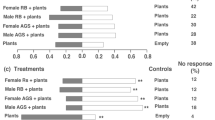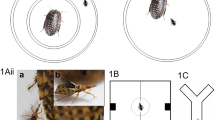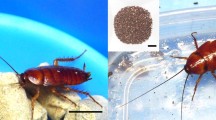Abstract
Fathead minnows (Pimephales promelas) that have never encountered a predatory pike (Esox lucius), are able to detect conspecific alarm pheromone in a pike's diet if the pike has recently consumed minnows. It remains unclear how this minnow alarm pheromone is secreted by pike and if a pike is able to avoid being labelled as a potential predator by localizing these cues away from its foraging range. The first experiment determined that minnow alarm pheromone is present in pike feces when pike are fed minnows. Individual fathead minnows exhibited a fright response to a stimulus of pike feces if the pike had been fed minnows, but not if the pike had been fed swordtails, which lack alarm pheromone. Individual minnows also exhibited a fright reaction to alarm pheromone in the water (which contained no feces) housing pike which had been fed minnows, suggesting that alarm pheromone is also released in urine, mucous secretions and/or via respiration. The second experiment determined that test pike spent a significantly greater proportion of time in the “home area” of the test tanks (i.e. where they were fed) but the majority of feces were deposited in the opposite end of the test tank. By localizing their defecation away from the home or foraging area, pike may be able to counter the effects of being labelled as a predator by the alarm pheromone of the prey species.
Similar content being viewed by others

References
Brown GE, Smith RJF (1994) Fathead minnows use chemical cues to discriminate natural shoalmates from unfamiliar conspecifics. J Chem Ecol 20:3051–3061
Chapman CA, MacKay WC (1984) Direct observation of habitat utilization of northern pike. Copeia 1984: 255–258
Chivers DP, Smith RJF (1994a) The role of experience and chemical alarm signalling in predator recognition by fathead minnows (Pimephales promelas). J Fish Biol 44: 273–285
Chivers DP, Smith RJF (in press) Fathead minnows (Pimephales promelas) learn to recognize chemical stimuli from high risk habitats by the presence of alarm substance. Behav Ecol
Chivers DP, Smith RJF (1994b) Fathead minnows (Pimephales promelas) acquire predator recognition when alarm substance is associated with the sight of unfamiliar fish. Anim Behav 48:597–605
Gelowitz CM, Mathis A, Smith RJF (1993) Chemosensory recognition of northern pike (Esox lucius) by brook stickleback (Culaea inconstans): population differences and the influence of predator diet. Behaviour 127: 105–118
Getty T (1987) Dear enemies and the Prisoner's Dilemma: why should territorial neighbors form defensive coalitions? Am Zool 27:327–336
Heczko E, Seghers BH (1981) Effects of alarm substance on schooling in the common shiner (Notropis cornutus, Cyprinidae). Environ Biol Fish 6: 25–29
Hobson ES (1979) Interactions between piscivorous fishes and their prey. In: Clepper H, Strout RH (eds) Predator-prey systems in fisheries management. Sport Fishing Institute, Washington D.C., pp 231–242
Högstedt G (1983) Adaptation unto death: function of fear screams. Am Nat 121: 562–570
Huntingford FA (1984) Some ethical issues raised by studies of predation and aggression. Anim Behav 32: 210–215
Keefe M (1992) Chemically mediated avoidance behaviour in wild brook trout, Salvelinus fontinalis: the response to familiar and unfamiliar predaceous fishes and the influence of fish diet. Can J Zool 70: 288–292
Keppel G (1982) Design and analysis, 2nd edn. Prentice Hall, Englewood Cliffs
Koenig WD, Stanback MT, Hooge PN (1991) Distress calls in the acorn woodpecker. Condor 93: 637–643
Krause J (1993) The effect of ‘Schreckstoff’ on the shoaling behaviour of the minnow — A test of Hamilton's selfish herd theory. Anim Behav 45:1019–1024
Lawler GH (1965) The food of the pike, Esox lucius, in Heming Lake, Manitoba. J Fish Res Bd Can 22: 1357–1377
Lawrence BJ, Smith RJF (1989) Behavioral response of solitary fathead minnows, Pimephales promelas, to alarm substance. J Chem Ecol 15: 209–219
Lima SL, Dill LM (1990) Behavioural decisions made under the risk of predation: a review and prospectus. Can J Zool 68: 619–640
Mathis A, Smith RJF (1993a) Fathead minnows, Pimephales promelas, learn to recognize northern pike, Esox lucius, as predators on the basis of chemical stimuli from minnows in the pike's diet. Anim Behav 46: 645–656
Mathis A, Smith RJF (1993b) Chemical alarm signals increase the survival time of fathead minnows (Pimephales promelas) during encounters with northern pike (Esox lucius). Behav Ecol 4: 260–265
Mathis A, Smith RJF (1993c) Chemical labeling of northern pike (Esox lucius) by the alarm pheromone of fathead minnows (Pimephales promelas). J Chem Ecol 19: 1967–1979
Mathis A, Chivers DP, Smith RJF (in press) Chemical alarm signals: predator-deterrents or predator-attractants. Am Nat
Mykytowycz R (1968) Territorial marking by rabbits. Sci Am 218: 116–126
Perrone M (1980) Factors affecting the incidence of distress calls in passerines. Wilson Bull 92: 404–408
Poole T (1985) Social behaviour in mammals. Blackie, Glasgow
Rehnberg BG, Smith RJF (1990) Behavioural and physiological responses to alarm pheromone by ostariophysan fishes and a possible modulating role for brain benzodiazepine receptors. In: Macdonald DW, Müller-Schwarz D, Natynczuk SE (eds) Chemical signals in vertebrates, vol 5. Oxford University Press, Oxford, pp 132–138
Savino JF, Stein RA (1989) Behavior of fish predators and their prey: habitat choice between open water and dense vegetation. Environ Biol Fish 24: 287–293
Scott WB, Crossman EJ (1973) Freshwater fishes of Canada. Fish Res Bd Can Bull 184
Shorey HH (1976) Animal communication by pheromones. Academic Press, New York
Siegel S (1956) Nonparametric statistics for the behavioural sciences. McGraw-Hill, New York
Siegel S, Castellan NJ (1988) Nonparametric statistics for the behavioural sciences, 2nd edn. McGraw-Hill, New York
Smith RJF (1973) Testosterone eliminates alarm substance in male fathead minnows. Can J Zool 51: 875–876
Smith RJF (1976) Seasonal loss of alarm substance cells in North American cyprinoid fishes and its relation to abrasive spawning behaviour. Can J Zool 54: 1172–1182
Smith RJF (1986) The evolution of chemical alarm signals in fishes. In: Duvall D, Müller-Schwarze D, Silverstein RM (eds) Chemical signals in vertebrates, vol. 4. Plenum, New York, pp 99–115
Smith RJF (1992) Alarm signals in fishes. Rev Fish Biol Fish 2: 33–63
Vogel S (1981) Life in moving fluids: the physical biology of flow. Willard Grant, Boston
Yamamoto I (1984) Latrine utilization and feces recognition in the racoon dog, Nyctereutes procyonoides. J Ethol 2: 47–54
Author information
Authors and Affiliations
Additional information
Communicated by G. M. Klump
Rights and permissions
About this article
Cite this article
Brown, G.E., Chivers, D.P. & Smith, R.J.F. Localized defecation by pike: a response to labelling by cyprinid alarm pheromone?. Behav Ecol Sociobiol 36, 105–110 (1995). https://doi.org/10.1007/BF00170715
Received:
Accepted:
Issue Date:
DOI: https://doi.org/10.1007/BF00170715



